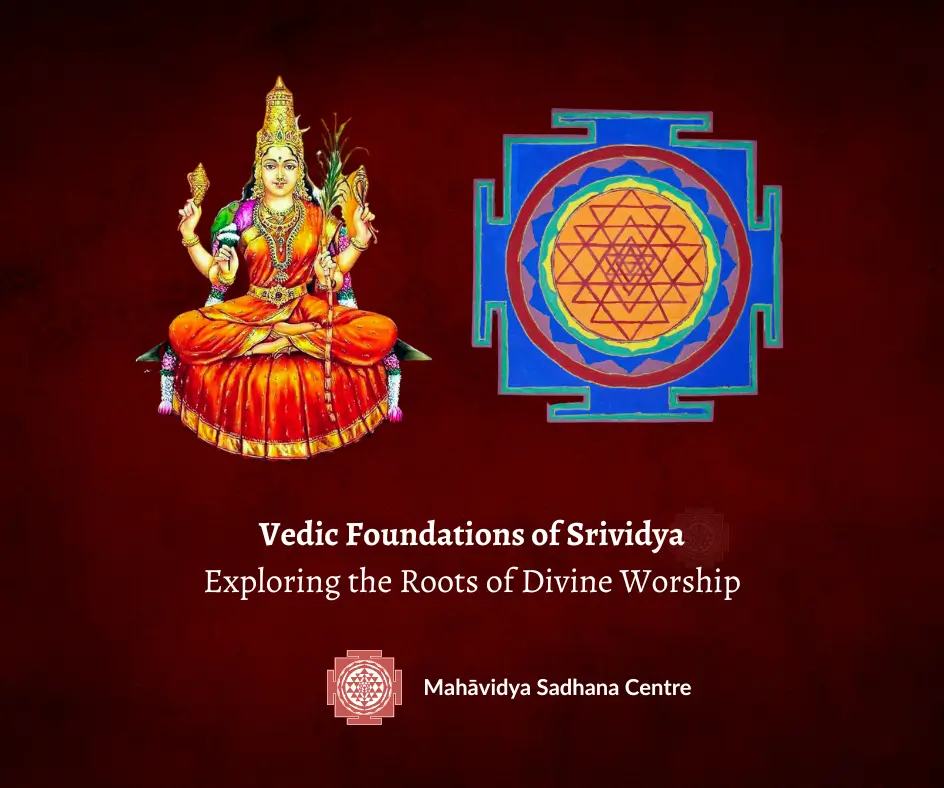Vedic Foundations of Srividya

Understanding Srividya: Its Practices and Philosophical Foundations
Delving into the enigmatic and ancient mystical tradition of Srividya takes us on a fascinating exploration of the mysterious world of Vedic mysticism. Srividya is a spiritual tradition dedicated to revering the Divine Mother Sri Lalitha Tripura Sundari. It incorporates a rich tapestry of mystical mantras, sacred geometric patterns, elaborate rituals and meditative practices, prompting an exploration into the cradle of ancient wisdom — the Vedas.
This quest takes us deep into the sacred essence of ancient Indian texts to reveal Srividya’s mystical roots. It leads us to a profound inquiry: How is Srividya reflected in the Vedas? As we sift through the Vedic literature, this article aims to illuminate the connection between Srividya’s mystical practices and Vedic traditions, unravelling the codification of the Panchadashi Maha Mantra and its spiritual lineage through the annals of time.
The Esoteric Wisdom of the Upanishads and Its Connection to Srividya
The Vedas, comprising the Rigveda, Samaveda, Yajurveda, and Atharvaveda, are the oldest texts of Sanatana Dharma (Hinduism) and form the bedrock of Vedic knowledge. They are divided into four parts:
- The Samhitas (hymns)
- The Brahmanas (rituals)
- The Aranyakas (meditative and ritual transition texts)
- The Upanishads (philosophical explorations and teachings)
The Vedas consist of different collections of texts, and one of their essential parts is the Samhitas. The Samhitas contain a variety of hymns, prayers, mantras, and rituals that form the basis for the Brahmanas. The Brahmanas, in turn, explain the rituals and ceremonies mentioned in the Samhitas through detailed instructions and background information. The Aranyakas are texts that transition between the Brahmanas and the philosophical Upanishads. They focus on the practice of Sadhana, which involves worship and meditation and is relevant for hermits and forest dwellers. The Upanishads, called Vedanta, are philosophical and spiritual teachings exploring concepts such as the Brahman and the Atman.
The Upanishads, also known as Vedanta, are the ultimate source of Vedic wisdom. The primary focus of the Upanishads is to explore the inner, esoteric meanings behind mantras, rituals and other spiritual concepts. These mantras are not merely recitations but are accompanied by deep philosophical meanings and discussions. They are intended to guide the practitioner from a state of ignorance to one of enlightenment, understanding, and self-realization. The Upanishads delve into the nature of existence, consciousness, and the universe, often through dialogues or teachings from a guru to a student. We can find traces of Srividya and its mantras within these sacred texts.
Deciphering the Secret Layers of the Panchadashi Maha Mantra
The term “Srividya” is not explicitly mentioned in the Vedic texts, but the principles and practices that define this tradition are deeply ingrained in the Upanishads. These texts contain many mantras essential for worshipping divine forms, reflecting the spiritual practices similar to those in Srividya. For example, the Narayanopanishad presents the Astakshari Narayana Mantra, which exemplifies how mantras are crucial for invoking divine energies. The practice of mantra recitation is a fundamental aspect of Srividya, demonstrating its roots in the broader Vedic tradition. These instances underscore the continuity of spiritual practices across different schools of thought and showcase the Upanishads’ critical role in preserving and teaching these sacred chants and rituals that connect directly to the divine.
The Panchadashi Maha Mantra is a crucial aspect of Srividya, which comprises 15 sacred syllables devoted to Sri Lalitha Tripura Sundari. Although not explicitly mentioned, this powerful mantra is subtly encoded within the Tripuropanishad through a sloka that uses symbolic language to conceal its profound essence. Bhaskararaya, a renowned Srividya scholar, expertly decodes this mantra in his seminal work “Varivasya Rahasya,” revealing its deep-rooted connections to the Vedas and its spiritual importance. His analysis uncovers the mantra’s structure and highlights its significance in the broader context of Vedic traditions and spiritual practices.
The Panchadashi Maha Mantra is an esoteric mantra originating from the Vedic tradition. It is codified in the Tripuropanishad, part of the Atharvaveda. The codification process involves encoding words representing various aspects of the universe and the Divine Mother. When decoded, these words form the Panchadashi Maha Mantra, a powerful tool for spiritual practice in the Srividya tradition. The encryption of the mantra highlights its sanctity, and its esoteric nature emphasizes the need for a qualified master to guide one in the practice of Srividya.
The Tripura Sundari Upanishad mentions the Panchadashi Mahamantra and explains its elements and significance. This mention confirms that Srividya is a part of Veda Vidya and plays an important role in the Vedic knowledge spectrum. Additionally, the Tripura Tapini Upanishad compares the Gayatri Mantra and the Panchadashi Mantra, emphasizing Srividya’s connection to Vedic wisdom. By making these connections, these texts highlight Srividya’s significant contribution to the Sanatana Dharma and its importance in the continued evolution and enrichment of spiritual practice within the Vedic tradition.
Srividya Across the Ages: Integration and Transformation
Over centuries, Srividya has evolved, integrating elements from various spiritual traditions, including Shakta and Shaiva, particularly from the Kashmir Shaiva school. The practice has diversified into different paths like Samayachara, Mishramachara, and Vamachara, reflecting variations in ritualistic practices and philosophical interpretations. Despite these other paths, the essence of Srividya is rooted in the Vedic scriptures and has remained unchanged. It is a spiritual practice that seeks to attain the union of the individual soul with the universal consciousness. The practice of Srividya is characterized by using mantras, yantras, and meditation techniques to awaken the Kundalini energy and attain spiritual enlightenment.



